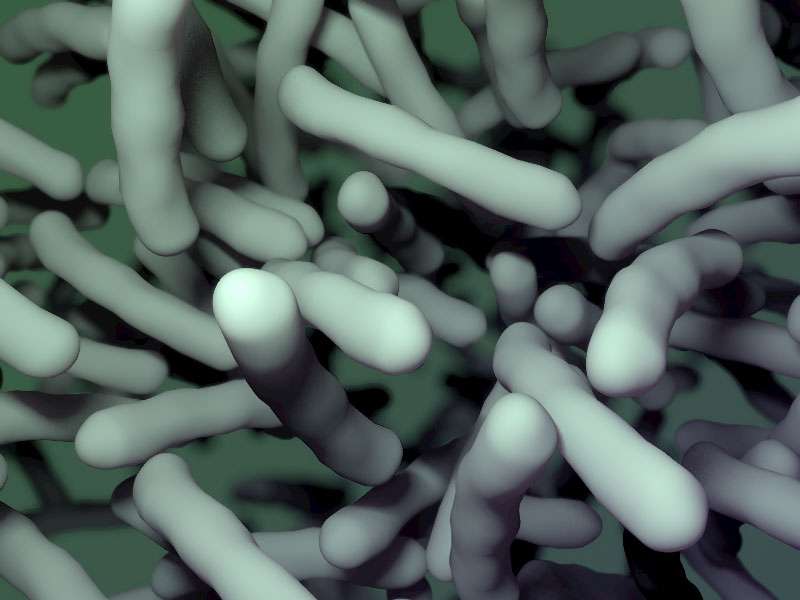Methicillin-resistant Staphylococcus aureus (MRSA) poses a major public health crisis worldwide. Researchers now identify new non-antibiotic compounds that can restore the bug’s susceptibility to antibiotics, offering a potential combination strategy against MRSA. Credit: V. Altounian / Science Translational Medicine (2016)
(Medical Xpress)—A team of researchers at pharmaceutical giant Merck has found a way to make anti-bacterial agents that have lost their ability to kill certain types of bacteria, become deadly again. In their paper published in Science Translational Medicine, the team describes the exhaustive study they conducted in searching for a molecule capable of interfering with one of the main defenses mechanisms bacteria have developed to resist antibacterial agents, the molecules they found and how effective they are in helping ß-lactams kill again.
Bacteria developing resistance to antibiotics has been well publicized, one such type in particular, Staphylococcus aureus, (MRSA) has become particularly troublesome—it is one of the more common bacteria types that cause staph infections, and has become immune to attack by ß-lactams, which include penicillin. Research has shown that one of the ways that MRSA became able to ward off attacks by ß-lactams was by fortifying its cell walls using building blocks known as teichoic acid. Prior research has also led to the discovery of molecules that are able to disrupt the building of such walls in their latter stages, but thus far have not proven to be effective in helping reduce resistance in MRSA. In this new effort, the researchers conducted an exhaustive search of molecules capable of interfering with the early stages of wall development, by building each molecule from scratch and testing it with another chemical that was known to inhibit later stage growth. The team reports that two molecules they created, tarocin A and B, were able to interrupt wall building at an early stage, which then allowed a dose of ß-lactams to move in for the kill.
Once the molecules were identified, the team set about bolstering their abilities and then conducted multiple tests of the abilities of both to help treat bacterial infections. They report that the combination proved successful in 82 percent of lab samples tested against MRSA and 72 percent effective against another common resistant bacteria known as MRSE. They also tested the combinations in mice infected with MRSA—those that got the double dose treatment showed signs of reduced infection, while those given just one of the drugs did not improve at all. Furthermore, the researchers also report that initial testing indicates that neither new molecule appears to cause any harm to human cells.
More information: S. H. Lee et al. TarO-specific inhibitors of wall teichoic acid biosynthesis restore -lactam efficacy against methicillin-resistant staphylococci, Science Translational Medicine (2016). DOI: 10.1126/scitranslmed.aad7364
Abstract
The widespread emergence of methicillin-resistant Staphylococcus aureus (MRSA) has dramatically eroded the efficacy of current β-lactam antibiotics and created an urgent need for new treatment options. We report an S. aureus phenotypic screening strategy involving chemical suppression of the growth inhibitory consequences of depleting late-stage wall teichoic acid biosynthesis. This enabled us to identify early-stage pathway-specific inhibitors of wall teichoic acid biosynthesis predicted to be chemically synergistic with β-lactams. We demonstrated by genetic and biochemical means that each of the new chemical series discovered, herein named tarocin A and tarocin B, inhibited the first step in wall teichoic acid biosynthesis (TarO). Tarocins do not have intrinsic bioactivity but rather demonstrated potent bactericidal synergy in combination with broad-spectrum β-lactam antibiotics against diverse clinical isolates of methicillin-resistant staphylococci as well as robust efficacy in a murine infection model of MRSA. Tarocins and other inhibitors of wall teichoic acid biosynthesis may provide a rational strategy to develop Gram-positive bactericidal β-lactam combination agents active against methicillin-resistant staphylococci.
Journal information: Science Translational Medicine
© 2016 Medical Xpress























